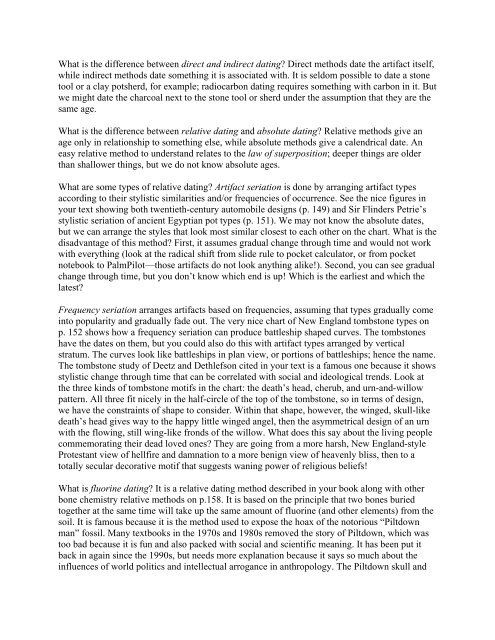INTRODUCTION TO ARCHAEOLOGY Nancy White - Touro Institute
INTRODUCTION TO ARCHAEOLOGY Nancy White - Touro Institute
INTRODUCTION TO ARCHAEOLOGY Nancy White - Touro Institute
Create successful ePaper yourself
Turn your PDF publications into a flip-book with our unique Google optimized e-Paper software.
What is the difference between direct and indirect dating? Direct methods date the artifact itself,<br />
while indirect methods date something it is associated with. It is seldom possible to date a stone<br />
tool or a clay potsherd, for example; radiocarbon dating requires something with carbon in it. But<br />
we might date the charcoal next to the stone tool or sherd under the assumption that they are the<br />
same age.<br />
What is the difference between relative dating and absolute dating? Relative methods give an<br />
age only in relationship to something else, while absolute methods give a calendrical date. An<br />
easy relative method to understand relates to the law of superposition; deeper things are older<br />
than shallower things, but we do not know absolute ages.<br />
What are some types of relative dating? Artifact seriation is done by arranging artifact types<br />
according to their stylistic similarities and/or frequencies of occurrence. See the nice figures in<br />
your text showing both twentieth-century automobile designs (p. 149) and Sir Flinders Petrie’s<br />
stylistic seriation of ancient Egyptian pot types (p. 151). We may not know the absolute dates,<br />
but we can arrange the styles that look most similar closest to each other on the chart. What is the<br />
disadvantage of this method? First, it assumes gradual change through time and would not work<br />
with everything (look at the radical shift from slide rule to pocket calculator, or from pocket<br />
notebook to PalmPilot—those artifacts do not look anything alike!). Second, you can see gradual<br />
change through time, but you don’t know which end is up! Which is the earliest and which the<br />
latest?<br />
Frequency seriation arranges artifacts based on frequencies, assuming that types gradually come<br />
into popularity and gradually fade out. The very nice chart of New England tombstone types on<br />
p. 152 shows how a frequency seriation can produce battleship shaped curves. The tombstones<br />
have the dates on them, but you could also do this with artifact types arranged by vertical<br />
stratum. The curves look like battleships in plan view, or portions of battleships; hence the name.<br />
The tombstone study of Deetz and Dethlefson cited in your text is a famous one because it shows<br />
stylistic change through time that can be correlated with social and ideological trends. Look at<br />
the three kinds of tombstone motifs in the chart: the death’s head, cherub, and urn-and-willow<br />
pattern. All three fit nicely in the half-circle of the top of the tombstone, so in terms of design,<br />
we have the constraints of shape to consider. Within that shape, however, the winged, skull-like<br />
death’s head gives way to the happy little winged angel, then the asymmetrical design of an urn<br />
with the flowing, still wing-like fronds of the willow. What does this say about the living people<br />
commemorating their dead loved ones? They are going from a more harsh, New England-style<br />
Protestant view of hellfire and damnation to a more benign view of heavenly bliss, then to a<br />
totally secular decorative motif that suggests waning power of religious beliefs!<br />
What is fluorine dating? It is a relative dating method described in your book along with other<br />
bone chemistry relative methods on p.158. It is based on the principle that two bones buried<br />
together at the same time will take up the same amount of fluorine (and other elements) from the<br />
soil. It is famous because it is the method used to expose the hoax of the notorious “Piltdown<br />
man” fossil. Many textbooks in the 1970s and 1980s removed the story of Piltdown, which was<br />
too bad because it is fun and also packed with social and scientific meaning. It has been put it<br />
back in again since the 1990s, but needs more explanation because it says so much about the<br />
influences of world politics and intellectual arrogance in anthropology. The Piltdown skull and
















